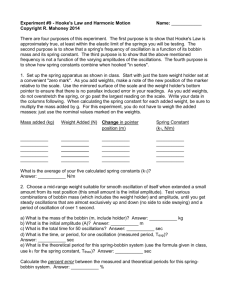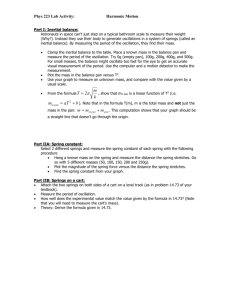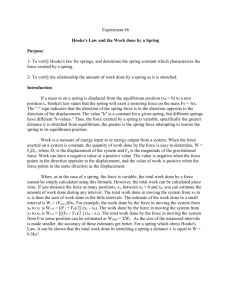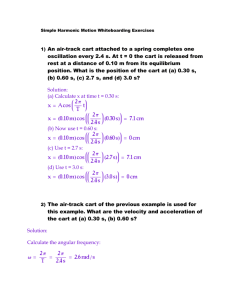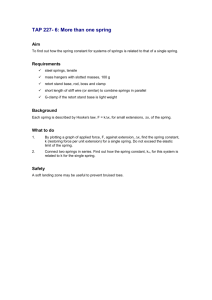Physics 105
advertisement
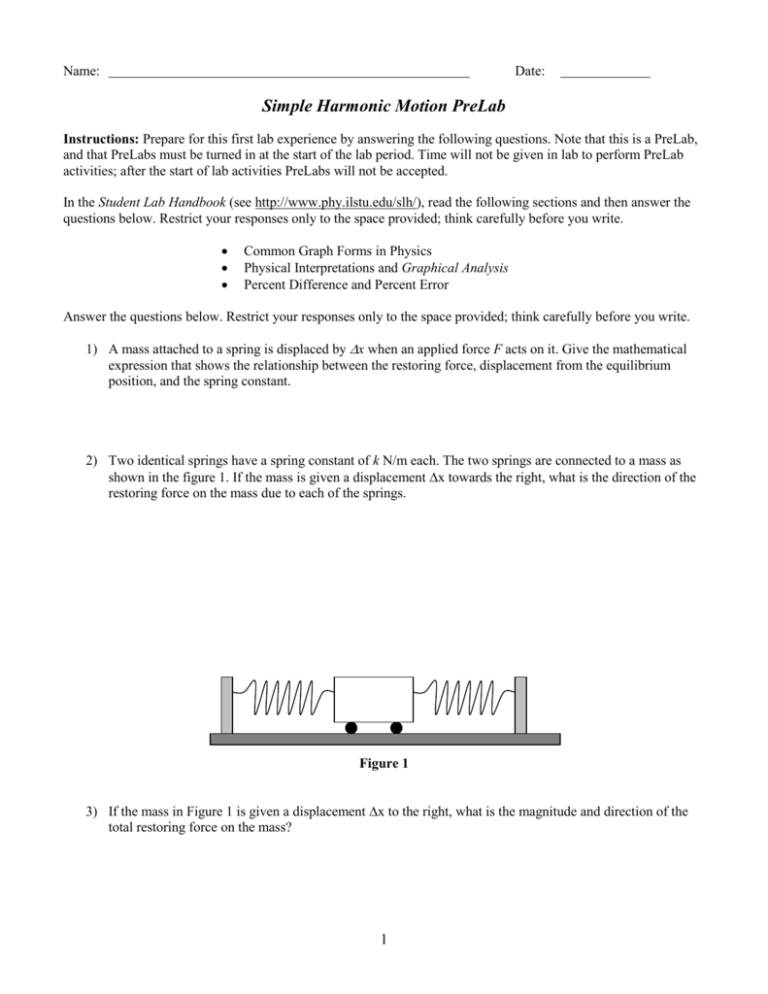
Name: Date: Simple Harmonic Motion PreLab Instructions: Prepare for this first lab experience by answering the following questions. Note that this is a PreLab, and that PreLabs must be turned in at the start of the lab period. Time will not be given in lab to perform PreLab activities; after the start of lab activities PreLabs will not be accepted. In the Student Lab Handbook (see http://www.phy.ilstu.edu/slh/), read the following sections and then answer the questions below. Restrict your responses only to the space provided; think carefully before you write. Common Graph Forms in Physics Physical Interpretations and Graphical Analysis Percent Difference and Percent Error Answer the questions below. Restrict your responses only to the space provided; think carefully before you write. 1) A mass attached to a spring is displaced by x when an applied force F acts on it. Give the mathematical expression that shows the relationship between the restoring force, displacement from the equilibrium position, and the spring constant. 2) Two identical springs have a spring constant of k N/m each. The two springs are connected to a mass as shown in the figure 1. If the mass is given a displacement x towards the right, what is the direction of the restoring force on the mass due to each of the springs. Figure 1 3) If the mass in Figure 1 is given a displacement x to the right, what is the magnitude and direction of the total restoring force on the mass? 1 2 4) Two identical springs have a spring constant of 10 N/m each. The two springs are connected to a mass as shown in the figure 2. If the mass is given a displacement x either up or down, what is the total restoring force on the mass? Figure 2 5) Two identical springs have a spring constant of k N/m each. The two springs are connected to a mass as shown in the figure 1. The mass is given a displacement of x = 10 cm, 20 cm, 30 cm, corresponding to forces of F = 1 N, 2 N and 3 N. What is the spring constant of each spring from this data in N/m? Hint: In questions 3) and 4) you are adding forces due to each spring. 6) The equation of a straight line is y = mx + b. Compare this with Hooke’s law, F = -kx and find what k corresponds to in this equation. Note that b = 0 in a physical interpretation because if x=0 then F=0. 7) A mass attached to a spring is displaced by x when an applied force F acts on it. Give the mathematical expression that shows the relationship between period of oscillation, mass and the spring constant? 8) Two identical springs have a spring constant of 10 N/m each. The two springs are connected to a 0.2 kg mass as shown in the figure 1. If the mass is given a displacement x, what is the period of oscillation for the mass? 3 Name: Date: Simple Harmonic Motion Lab Guidelines Objectives: As a result of this lab, the students will Develop a conceptual understanding of “simple harmonic motion”. Develop a conceptual understanding of Hooke’s law. Demonstrate how to find spring constants of springs Find the relationships (if any) between amplitude, mass, and period of oscillation in a simple harmonic motion. Task 1: Find the relationship between applied force and displacement from the equilibrium position of the small, vertically hung spring. CAUTION: Over-stretching a spring can permanently damage it. You should not add more than 50 grams total to the 50-gram weight hanger. That is, you should not suspend more then 100 total grams on the small spring. Your data collection with the small spring should have a mass range of only 50 grams which is adequate for the purposes of this lab. Q1. What procedure you will adopt to determine the relationship between applied force and displacement from the equilibrium position, including what data you will collect. Q2. Compute the constant of proportionality using a graph; be certain to use a physical interpretation. Label your output Graph 1. Attach a labeled graph with your answer sheet. Note that this constant of proportionality is known as the spring constant, and will be identified with k throughout this laboratory activity. Task 2: Create a simplifying horizontal spring system. With the materials provided, design an experimental setup in which you make a cart oscillate between two end points on a horizontal track. Note: A “simplifying” horizontal spring system is used this time to avoid the complicating factor of a vertical moving spring. Vertical springs effectively add mass to the system equal to roughly 1/3 their mass. Q3. Did you choose to use only one spring or two? Explain the advantage of using two springs, if any. Q4. With two springs, what do you think the effective spring constant, keff, will be for such a system, 0.5k, 1k, 2k? Explain your reasoning. 4 Task 3: Dependent and independent system variables and dimensional analysis. Q5. Which variables of the simplifying horizontal spring system above might possibly affect the period of oscillation? List all that you can think of. Q6. Conduct a qualitative experiment (don’t look at the numbers; seek only to identify trends from visual observation) to determine which of the systems independent variables has a significantly influence on the period of oscillation. Ignore minor variations. Q7. From your analyses in step 2, you should have found that the period of oscillation is a function of only two particular variables. Operating under this assumption (unless you can find other more variables that might affect period in a horizontal spring system), conduct a dimensional analysis between these variables and the period of oscillation to determine the expected form of the actual physical relationship. Show all work. Task 4: Experimentally determine the relationship between the period of oscillation and the cart mass of a horizontal spring system. a. Conduct an experiment with your setup to collect data about the relationship between the mass of the cart and the period of oscillation for the horizontal spring-mass system. b. Using Graphical Analysis, determine the relationship between the period of oscillation and cart mass of the system. Be certain to use a physical interpretation as you conduct your curve fitting. Generate a graph of your relationship using a physical interpretation. Label it Graph 1, and include with your lab report. Caution: Use the results of your dimensional analysis to serve as a guide as you conduct the curve-fitting routine; the “wings” of a parabola will often look like straight lines. Q9. What sort of relationship did you find? Directly proportional? Inversely proportional? Other? 5 Q10. How well does your finding agree with your prediction from dimensional analysis? State the value of the RMSE (root mean square error). For a given set of data, the smaller the RMSE the better. Task 5: Find the complete relationship between pertinent system variables and the period of oscillation of the system. a. Your result from task 4 should be of the following form: T const(1) m where const(1) contains the factor of 0.5k, 1k, 2k. According to theory, the actual form of the physical relationship should be: T 2 m keff b. This being the case, then const (1) 2 / keff or keff 4 2 const(1) 2 . Compute the value for keff and see if your prediction for the form of keff was correct. Q11. Was your prediction for the form of keff was correct? If not, why not? c. Using the correct form of keff, compute const(2) from the following relationship: const (2) const (1) keff Note that this relationship comes from the following relationship: T const(2) m. keff Q12. Compute the % effort between const(2) and 2 from the theoretical period of oscillation. Show your work. 6 Experiment Simple Harmonic Motion – Notes for TA’s Task 1: Setup Students should be able to figure out the setup similar to as shown in the figure below. There will be some initial resistance from them and they would want to know what is the right way. I feel it is important for them to experiment and perhaps even learn and borrow ideas from other groups. If they have done the pre lab, than it should not take them a lot of time to realize the similarities to figure 1 of the pre lab. They should level the track and measure the mass of the cart and the equilibrium position after hooking up the springs. The cart has holes to hook up the springs. Task 2: Spring constant. There are two springs that need to be used for the experiment to work. The effective spring constant is equal to the sum of two individual spring constants. Since the springs are identical, this means that each spring constant is half of the effective spring constant they will determine. The basic idea is to obtain data to plot force versus displacement. The slope of the straight line will give the effective spring constant. An example data table is shown here. Mass of the cart (m) in kg = _____ Equilibrium position of the cart in meters x1 = _____ 1 A M = Mass on the hanger + mass of the hanger (0.005kg) in kg B Position of the cart in meters x2 C Displacement from equilibrium in meters x =|x1 - x2| D F=Mg in N (mass from column A) 2 3 4 5 6 Task 3: Experimental period of Oscillation. Students should detach the mass hanger for this task and measure time for 5 oscillations. They should do this at least a total of five times to account for statistical variation. Five because it is an odd number and helps decide the majority in case half of the measurements are of one value and the other half another value. They should choose and record the amplitude. See example table for task 4. Task 4: Mass and period of Oscillation. 7 Same as task 3, except that they now put mass on the cart. I suggested 0.5 kg in the table, but students can experiment with several different ones. Amplitude in m _________ 1 2 3 A Type B Trial 1 Sec. C Trial 2 Sec. D Trial 3 Sec. E Trial 4 Sec. F Trial 5 Sec. G Average Sec. H Period Sec. Cart Without mass (m) With 0.5 kg on the cart (m + 0.5 kg) Task 5: Amplitude and period of Oscillation. Students should give the amplitude and do this similar to task 3 and 4 with same type of table. Students should be able to deduct from there experiment that period of oscillation does not depend on amplitude as can be seen in equation 2. 8
